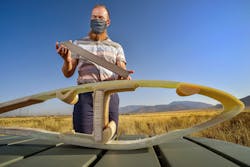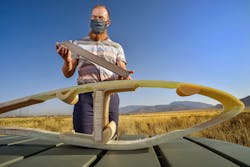New Carbon Fiber Material Targeted for Wind Turbine Blades
Researchers at Oak Ridge National Laboratory developed a low-cost carbon fiber that could lower the cost of blades for wind turbines.
The fiber begins as widely available raw material used in the textile industry that contains thick bundles of acrylic fibers. The material is heated, which converts any fiber in the material to carbon. The fibers are converted to planks using pultrusion—a process like extrusion, except the material is pulled though a die rather than pushed through. This process creates carbon fibers with the strength and performance characteristics suitable for making wind turbine blades. The process is also well suited to being scaled up to high-volume production.
ORNL sent samples of its new fiber, composites made from it and similar composites made from commercially available carbon fiber to Montana State University to compare their performance and measure their mechanical properties. The MSU team also included standard fiberglass composites in the study.
Researchers at Sandia National Lab then took the blade’s mechanical properties and cost modeling results from ORNL, and used them to analyze a model of a theoretical turbine blades using the new carbon fibers in composites for the spar cap, the main structural support.
They found that the new fiber material had 56% more compressive strength per dollar than commercially available carbon fiber, the industry baseline. Typically, manufacturers compensate for lower compressive strength by using more material, which increases costs and the weight of the blade. The team estimates that the new material would cut about 40% from the material costs for a spar cap compared to commercial carbon fibers.
The new fiber also cut predicted materials costs compared to fiberglass for land-based turbines, thanks to its better fatigue resistance and increased fatigue life. The turbine cold also be designed differently to garner even more cost and performance benefits from the new carbon fiber.
Turbine engineers know that blades made from carbon fiber weigh 25% less than ones made from traditional fiberglass and that carbon-fiber blades could be longer than fiberglass ones and capture more energy in locations with low wind. A switch to carbon fiber could also extend blade lifetime because carbon fibers have more fatigue resistance.
Due to the high cost of carbon-fiber composite blades, only one firm uses them extensively in its blade designs. But wind turbine blades are the largest single-piece composite structures in the world, and the wind industry could represent the largest market for carbon fiber materials by weight if a material that competed on a cost-value basis to fiberglass reinforced composites was commercially available. The new carbon fiber could open the door for this to happen.
However, the wind and carbon fiber industries do not currently overlap. The wind industry designs wind turbine blades using only commercially available materials, and the carbon fiber manufacturers face a hurdle to innovation due to high capital costs associated with introducing a new production line for the wind industry.

